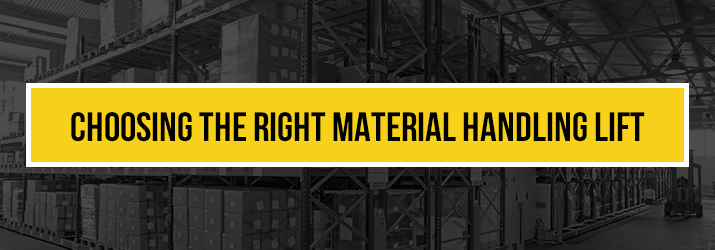
Whether you’re looking to buy or rent a material handling lift, you want the most cost-effective option. There are several lifts to choose from, ranging in size, capacity and lift height. There are other factors to consider as well, such as environment (indoor vs. outdoor) and surface texture (level vs. rough terrain).
Jump to Section:
- Pallet Jacks
- Forklifts
- Telehandlers
- Boom Trucks
- Fork Attachments
- Cranes
- Which Type of Lift Equipment Is Right for Me?
- Material Handling Lift by Industry
- Material Handling Equipment Rentals
- Training and Certification for Material Handling Equipment
In this guide, we’ve laid out an explanation of each piece of equipment, the pros and cons of each and a list of common material handling uses.
Pallet Jacks
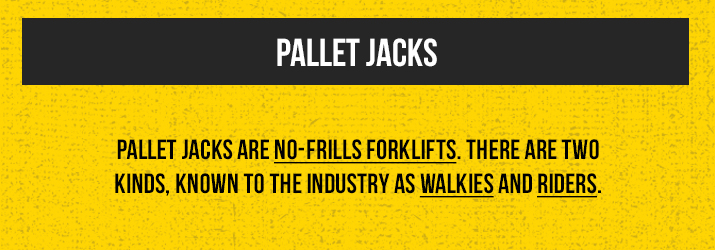
Pallet jacks are no-frills forklifts. There are two kinds, known to the industry as walkies and riders.
Walkies (or walk-behind) can be manual or powered. Manual walkies are simply pushed from behind by the operator, while a powered model will move on its own — at a slow pace. Powered walkies reach a maximum speed of four miles per hour. Both manual and powered can hold a capacity of 4,500 to 6,000 pounds and have forks ranging from 32 inches to 60 inches deep — one or two pallets’ length.
Riders go faster and can handle a larger capacity. With this type of pallet jack, the operator stands on a platform, steering with a handle or tiller. Unloaded, riders can hit a top speed of about nine miles per hour, and there’s more flexibility in depth, with the ability to get forks between 36 inches and 144 inches deep — one, two or three pallets’ length.
There is some variety among the speed and capacity of pallet jacks. Regardless of whether you’re considering a walkie or a rider, pallet jacks have their own set of pros and cons when compared to other material handling equipment. We’ve listed a few below.
Pros
- More affordable than a traditional forklift
- Less training required to operate
- Ability to fit in smaller spaces
- Less expensive to operate and maintain
Cons
- Limited vertical reach
- Slower speed than a traditional forklift
- Unable to navigate rough terrain
Forklifts
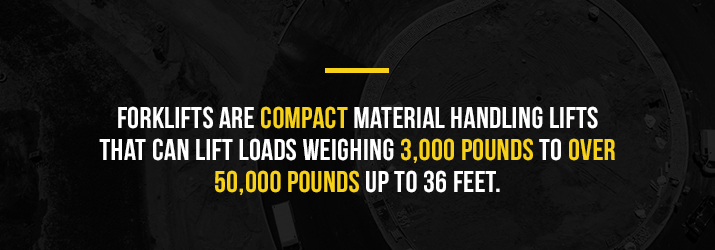
Forklifts are compact material handling lifts that can lift loads weighing 3,000 pounds to over 50,000 pounds up to 36 feet. There are a variety of models available to suit your specific needs.
One thing to keep in mind is the load center. The maximum capacity is measured at a 24-inch load center — which is the measurement from the forklift to the center of the object you’re lifting. If the object is longer, with a 36-inch load center, the capacity will be less.
There are also a few different types of forklifts available:
- Internal Combustion (IC) vs. Electric Power
While capacity and lift height are two of the measurements you’ll use to determine the model that will be best for you, there are other differences to be aware of. The first is power. Internal combustion (IC) models are the most common — powered by gasoline, diesel fuel, liquid propane gas or compressed natural gas.There are also electric models, which are ideal for use indoors. Electric models do need to be charged on a regular basis, so that’s something to take into consideration. Another difference you’ll see is the number of wheels and types of tires. While four-wheel models are the most common, three-wheel models exist and are great for navigating small areas with lots of turns. - Cushion vs. Pneumatic Tires
The types of tires are another factor to consider. Usually, the specific model that aligns best with your lift height and capacity will fit a specific type of tires, but it’s still helpful to know what the types are — and what they work best for. Cushion tires are great for work that will be done on a smooth surface, like concrete or asphalt. These tires ride lower to the ground, making them ideal for areas where there is low clearance. If you’ll be working on an uneven surface — like loose gravel or a yard, pneumatic tires are probably best. Forklifts with pneumatic tires are primarily built for outdoor use, but they are also great for use in a large warehouse. If you’re working in an area where you have a high risk of puncturing your tires, it is possible to get “solid pneumatic” tires. The range of jobs a forklift with pneumatic tires is capable of doing make it a versatile option if you have a variety of needs.
Rough Terrain Forklifts
While pneumatic tires can help you complete a variety of tasks, there’s another option if you need something a little more rugged. If you’re working on an outdoor surface that requires more traction, a rough-terrain forklift will work best for you. Equipped with large tires that resemble those on a tractor, this type of forklift can navigate the most challenging terrain.
Within this type of forklift, you can also choose between two-wheel or four-wheel drive. Because of their ability to traverse a difficult landscape, you’ll often find these forklifts on construction sites or lumber yards. Some of them even have a telescoping mast to help lift building materials higher.
Pros
- Compact size to maneuver in small spaces.
- Diverse range of reach and capacity options give you the most cost-effective option.
- Limited training required to operate (additional training for rough-terrain models).
- Flexibility for indoor and outdoor use (depending on the model).
Cons
- Limited to lift heights of 36 feet.
- Limited to a capacity of 80,000 pounds.
- Load center can prevent lifting irregular objects.
- Additional time required for charging an electric forklift.
Telehandlers
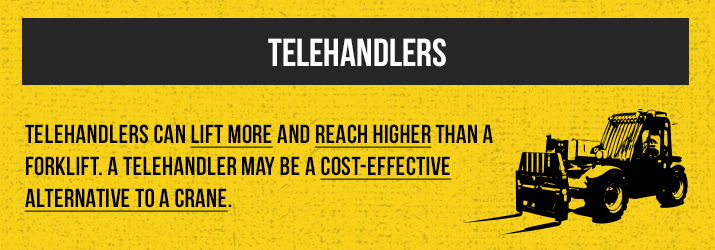
Telehandlers are material handling lifts that can lift more and reach higher than a forklift. Depending on capacity and lift height demands, a telehandler may be a cost-effective alternative to a crane.
These lifts are mounted on a four-wheel drive chassis and have a telescopic boom that allows them to reach forward, but also upward. There are several different attachments you can buy for the end of a telehandler. If you want something similar to a forklift, you can add pallet forks. A few other common attachments are buckets, platforms and lifting jibs.
In addition to standard telehandlers, there are compact telehandlers. As the name implies, they are smaller and weigh less. They are also easier to maneuver and easier to transport. However, the smaller size means less capacity and lift height.
Pros
- Higher capacity and lift height than forklifts.
- Attachments provide versatility.
Cons
- Unable to fit into and navigate small spaces due to size.
Boom Trucks
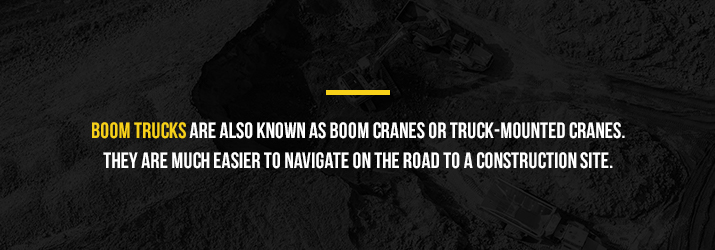
Boom trucks are also known as boom cranes or truck-mounted cranes. They’re essentially a crane mounted on the back of a truck, without counterweights. They are much easier to navigate on the road to a construction site when compared to the various other types of cranes. However, the trait that makes them good for travel — standard, rubber wheels — makes them unable to take on any sort of rough terrain. Plus, with the convenient, lighter weight comes less capacity and lift height. Outriggers also need to be added to the base of the truck to provide stability while the truck is in use.
Pros
- Designed for mobility — won’t need to be hauled to the site.
- Handles capacity up to 50 tons.
Cons
- Can’t handle rough terrain.
- Capacity is less than stationary cranes.
Fork Attachments
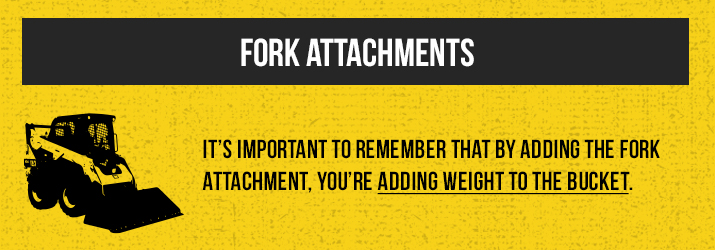
If you already have a backhoe, skid loader or wheel loader to move materials, you can add a fork attachment to any of these pieces of equipment to be able to move different types of materials. These attachments fit directly to the top and bottom of the bucket on a backhoe, skid loader or wheel loader. You can get an attachment that matches the exact dimensions (height and width) of your bucket. The forks extend forward from the bottom of the bucket. You can even choose from a variety of fork lengths and designs.
When it comes to capacity and lift height, you’ll want to reference the amounts for your backhoe, skid loader or wheel loader. However, it’s important to remember that by adding the fork attachment, you’re adding weight to the bucket. Your capacity for lifting materials will be the capacity of your piece of equipment, minus the weight of the attachment. If this number meets your lifting needs, a fork attachment may be a convenient option for you.
Pros
- Less expensive than buying another piece of equipment.
- Takes up less storage space.
- Costs less to maintain than a piece of equipment.
Cons
- Less capacity for materials because you must consider the weight of the fork attachment.
- Fork attachment increases load center, increasing the risk of tipping over.
Cranes

Cranes provide the highest numbers regarding capacity and height, but not all cranes are created equal. Carry deck cranes, rough-terrain cranes, all-terrain cranes and crawler cranes are four of the most common that are used for material handling.
- Carry Deck Cranes
This type of crane is recognized for being the most versatile, which is not a term that typically applies to cranes. Carry deck cranes are low-profile, compact cranes, making them the perfect fit for lifting materials while navigating tight spaces and overhead obstacles. Even within this model of crane, there are a variety of sizes and capacities, giving you the ultimate lifting flexibility. - Rough-Terrain Crane
If you’re searching for a boom crane that can handle rough terrain, this is the type of crane you’ll want. It is technically a vehicle mounted crane, but with four large tires designed specifically to take on rough terrain. It also contains outriggers at its base to provide stability. - Crawler Crane
Crawler cranes have tracks instead of wheels, so there’s no need for outriggers on this crane model — they get their stability from their tracks. Since there is no need for outriggers, the tracks also allow this type of crane to move while carrying materials. - All-Terrain Crane
An all-terrain crane is the version of the boom crane that can move just as well off-road as it can on pavement. With twelve wheels, this crane maintains its balance in rough terrain. If you’re in the market for both a boom truck and a rough-terrain crane, an all-terrain variety can give you the best of both in one piece of equipment.
Pros
- Highest capacity of all material handling lifts.
Cons
- Slow and expensive to transport.
Which Type of Lifting Equipment Is Right for Me?
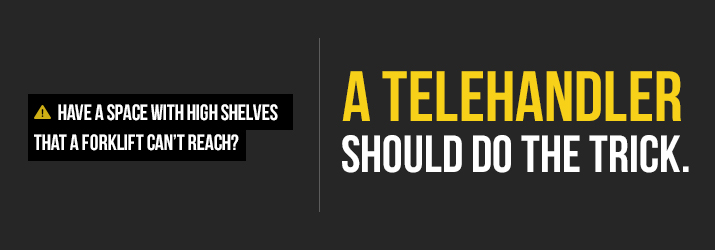
Even with the explanation and pros and cons of each type of material handling lift, you may still not know exactly what piece of equipment is best for your job. To help you decide, we’ve included examples of equipment that is most common in specific industries, in addition to a few common examples of situations that require this type of equipment.
Along with each situation, we’ve described which piece of equipment would likely be best suited for the job. It’s important to keep in mind that these are generalizations, and you should be sure the piece of equipment you choose can handle your heaviest material load for the height or distance it needs to go.
Material Handling Lifts by Industry
Here is a breakdown of which equipment types will suit you best based on your industry:
- Landscaping – Moving large plants and dirt make forklifts, backhoes, skid loaders and wheel loaders popular in the landscaping industry. These machines are often used to dig holes and move dirt, soil, mulch and stones. They may also be used alone or with the help of a forklift or fork attachment to move and place large plants.
- Home Construction and Renovations – When it comes to new home construction or home renovations, telehandlers, forklifts, backhoes, skid loaders, wheel loaders are used frequently. They carry dirt to create a space for the foundation, as well as carry supplies, like drywall, pipes, etc. The piece(s) of equipment you use depends on the size of the project, amount of supplies and the landscape. While some may work with the straight up and down lift of a forklift, or the limited reach of a backhoe, skid loader or wheel loader, a telehandler may be needed to reach higher. A boom truck or crane may also be used to place modular pieces on a foundation.
- Heavy Construction – Projects that fall into the category of heavy construction may use a variety of material handling lifts, but the heaviest duty of them all is the crane. Cranes have the largest capacity and are used to lift and move the biggest, heaviest materials, regardless of what the specifics of the project are.
- Agriculture – In the agriculture industry, there is a diverse range of materials that need to be lifted and moved. You need a lift that can meet that diverse demand, and telehandlers, rough-terrain forklifts, backhoes, skid loaders and wheel loaders are all up to the challenge. These lifts are among the most versatile, serving a variety of needs on your farm, whether you have crops, animals or both.
- Lumber/Forestry – Rough terrain forklifts and telehandlers are two pieces of equipment that are common in working with lumber. The deciding factor is often in how much lumber you’re moving and how high/what angle it needs to be lifted to. While both of these pieces of equipment can maneuver the rough terrain, telehandlers offer more flexibility in lift height and angle.
- Waste/Recycling – Moving trash bins, recycling bins or dumpsters requires a material handling lift. Frequently forklifts and telehandlers are used to lift full bins onto a truck and fresh empty bins into place. Once the trash makes it to the landfill, or the recyclables make it to the recycling center, these lifts are used to pick up and move the materials into other equipment or other containers.
- Warehousing/Shipping – Pallet jacks and forklifts are frequently used individually, or together, to load and unload trucks and navigate the aisles of a warehouse as you move inventory.
In addition to the various industries, there are also situations that will require different equipment. Take a look at the following:
- I need to move materials in a warehouse or storage area with shelves.
Navigating warehouses can be tricky, but usually, forklifts are the best solution. There are a few options for indoor use — including an electric model. Forklifts are often able to navigate shelves and move at a quick pace. They only require one operator, and the training to learn how to operate them is relatively straightforward.
Have a space with high shelves that a forklift can’t reach? A telehandler should do the trick. - I need to move heavy materials outdoors.
If you’re moving material that weighs more than 30 tons on a construction site outdoors, you’re going to need a crane. While boom trucks are sometimes able to do the job for weights under 30 tons, you don’t want to risk it. Because boom trucks don’t have counter weights, if you’re pushing their limit, you could end up tipping or rolling the truck.
Do you need to move the heavy materials more than the reach of the crane? If so, consider a crawler crane, which has tracks, instead of wheels. This eliminates the need for outriggers and enables the crane to transport heavy loads.
Do you need to move the heavy materials on rough terrain? If so, you should consider a rough-terrain or all-terrain crane to ensure you have the support and stability you’re looking for. - I need to move light materials on or off trailers or production lines.
Often referred to as dock work, this is an area that pallet jacks are particularly good for. They’re small, making them ideal for getting in between trucks and trailers or production lines.
While they may not have a fast speed, they are great for navigating through small, narrow areas and can usually do the job as long as it doesn’t require moving anything over 6,000 pounds or reaching higher than a shelf elevated just off the ground. If you do need for something that reaches higher, consider pairing a pallet jack with a forklift. - I need to move light materials outdoors.
If you’re moving light materials outdoors, as long as the materials aren’t awkwardly shaped, a forklift should be able to do the job. With capacities of over 100,000 pounds, as long as the load center will fit correctly on the forklift, there are plenty of options to help you move your materials from point A to point B.
However, if the materials will not fit on the forks of a forklift and the load center would be too far above the 24- to 36-inch range, you may need to consider a telehandler or boom truck. - I need to move moderately heavy materials outdoors.
If the load is too much for a telehandler, the next step up for capacity is a boom truck. This boom crane’s design gives it the best of both worlds — the ability to move easily and to lift moderately heavy (up to 50 tons) materials.
However, if your outdoor location isn’t on a road or similar ground, you may need to consider taking a step up to a rough-terrain crane or an all-terrain crane, both of which provide more stability on rough terrain.
Material Handling Equipment Rentals

There are a lot of things to consider when you’re choosing the right material handling lift for your job. While capacity, lift height and size remain the key factors to consider, it’s important to understand the pros and cons of each piece of equipment so that you can make the most cost-effective option for your needs.
If your need is short-term or if it’s more cost-effective to find material handling equipment rentals, MacAllister Rentals has your equipment needs covered. Visit our equipment rental page to learn more about the rental material handling equipment we have available in Indiana and Michigan today.
Training and Certification for Material Handling Equipment
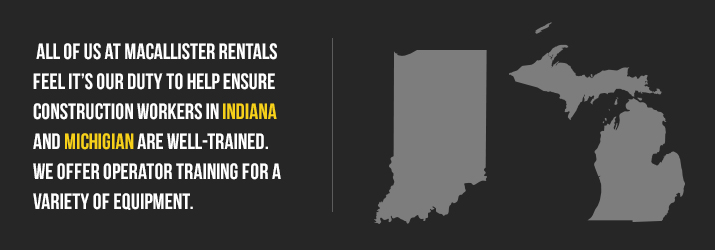
In addition to deciding which type of material handling equipment is best for the job, you will need a trained operator. The level of training required varies greatly depending upon the piece of equipment. For example, there is significantly more training required for a crane operator than there is for operating a pallet jack. When it comes to training, usually the bigger the piece of equipment and the material you’re lifting, the more training will be necessary.
Regardless of the level of training that’s required, the process often combines lecture and reading with operating the piece of equipment under supervision. Then, once the individual has completed the training and operates the piece of material handling equipment to your satisfaction, they receive a certificate. It’s important to note there may be additional training required based on the type of material you are moving.
The Occupational Safety and Health Administration (OSHA) outlines the training you, as an employer, are required to provide the operators of your material handling equipment in subpart N of its Training Requirements in OSHA Standards document.
Making sure your material handling equipment operators have all of the training they need can be overwhelming. As a material handling equipment rental company, all of us at MacAllister Rentals feel it’s our duty to help ensure construction workers in Indiana and Michigan are well-trained. We offer operator training for a variety of equipment. If we don’t offer the training you need, we can help you get in touch with someone who does. For more information, visit the operator training page of our website.
